There are a lot of prosperous parks in Baki. Each of these parks located in different parts of the capital has its own infrastructure, numerous cafes, restaurants, attractions and children’s playgrounds. The first park in the city was opened in the middle of the 30th years of XIX century since the opening of the Governor’s garden every year dozens of new parks and gardens are available in the city.In these places people can relax, walk with their children, communicate with friends, or just can be absorbed loneliness.
Referring to among the residents of the capital and visitors to our beautiful city provides a list of the parks which gained popularity and the interest
Baku Seaside Park
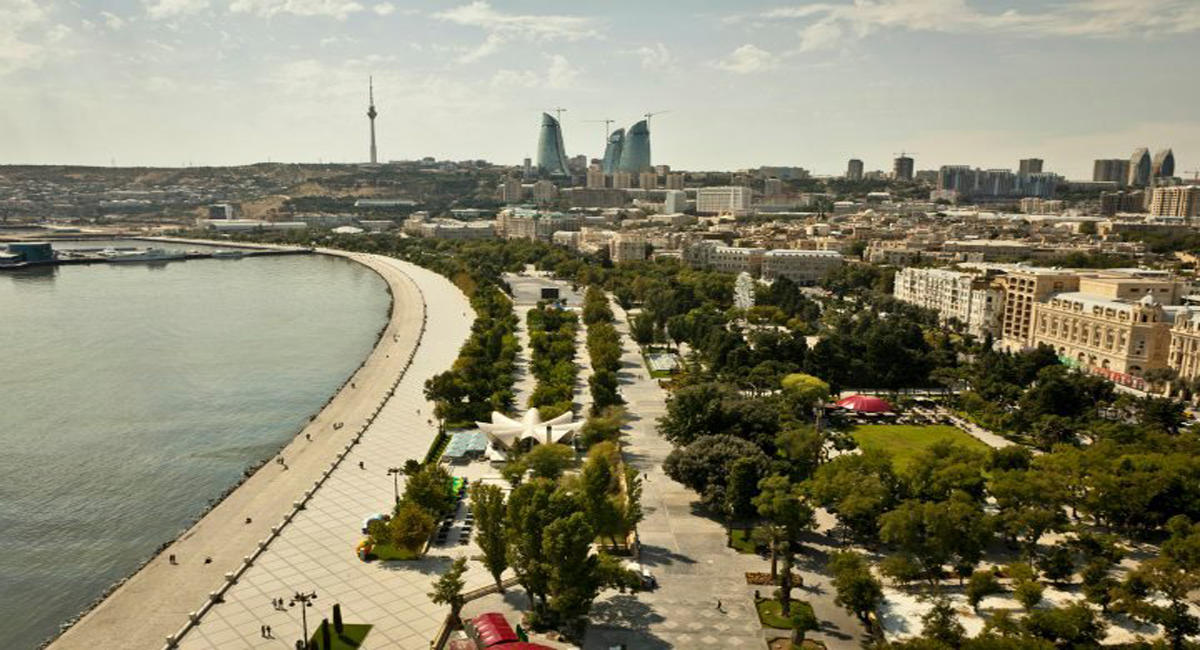 Baku Seaside Park – the famous Boulevard – one of the best sights of the capital of Azerbaijan, a favorite and lovely place for recreation of Baku citizens and guests of the city. In 2009, was celebrated 100th anniversary of Baki boulevard. The length of the park, which today equals 5 km 600 meters, after the general reconstruction will be 25 km.
Baku Seaside Park – the famous Boulevard – one of the best sights of the capital of Azerbaijan, a favorite and lovely place for recreation of Baku citizens and guests of the city. In 2009, was celebrated 100th anniversary of Baki boulevard. The length of the park, which today equals 5 km 600 meters, after the general reconstruction will be 25 km.
In 2007, in Seaside Park, opposite the “Azneft” Square, the opening of a musical fountain, which has no analogue in the world, was held. In 2008, the construction of the second fountain, which was built opposite the Government House, was completed.
In the seaside park there is everything for a meaningful family holiday – dozens of diverse attractions, carousels, “ferris wheel”, 7D cinema, cafes, the summer cinema “Bahar”, summer children’s theater and a parachute tower. There is also the legendary summer cafe “Pearl”, built in the 60s of the last century, and located on the overpass, going to sea, cafe “Sadko”. For lovers of sea walks, passenger ships run, Yacht Club and a floating restaurant operate. And one of the corners of Boulevard was even called Baku’s Venice: here boats and gondolas cruise along artificial narrow canals, just like in that Italian town.
The popular shopping and entertainment center Park Bulvar, the International Mugham Center and the famous Museum of the Azerbaijani carpet are also located in the Baku Seaside Park.
To the joy of adults and children Seaside park is buried in flowers and greenery. On the anniversary of the boulevard from different countries, various exotic plants and shrubs were brought here, in particular, Argentine baobabs weighing 7 tons each and over 150 years old, huge cacti, tall olive trees and palms.
In connection with the decree of the President, since 2008 the general reconstruction of Primorsky Park has been carried out, for which the Mayor’s Office of Baku allocated a total of $ 500 million. The territory of the Seaside Park is constantly growing and will eventually be increased five times from the original. From one end it will stretch from the sea station to the village of Zykh, and from the other beginning from the Palace of hand games to the Bibi-Heybat mosque.
In 2014, in the new part of the Primorsky National Park, stretching to the State Flag Square, a modern panorama (“Ferris wheel”) 60 meters in diameter was opened, in which there are 30 eight-seater glazed cabins.
Philharmonic Garden in Baku (Governor’s Garden)
 The Philharmonic Garden, formerly known as Mikhailovsky, the Governor’s Garden, the Garden of Revolution or the Philharmonic Garden is one of the oldest parks in the capital of Azerbaijan, in the city of Baku. And the “Gubernatorsky” garden was called for the reason that it was in front of the Governor’s House. The garden is located near the eastern Small Fortress wall of the old town of Icheri Sheher, between the eastern fortress gates and the Azneft square.
The Philharmonic Garden, formerly known as Mikhailovsky, the Governor’s Garden, the Garden of Revolution or the Philharmonic Garden is one of the oldest parks in the capital of Azerbaijan, in the city of Baku. And the “Gubernatorsky” garden was called for the reason that it was in front of the Governor’s House. The garden is located near the eastern Small Fortress wall of the old town of Icheri Sheher, between the eastern fortress gates and the Azneft square.
This garden, with a total area of 4.6 hectares, has a very interesting story. It was defeated in the 30s of the XIX century in the place of private gardens and orchards, and for a long time remained the only garden in the city. The landscape of the Governor’s garden was created and formed over half a century.
The commandant of the city ordered the captains and owners of ships coming from Lankaran and Iran to Baku to bring a few bags of earth to lay the gardens; Someone who does not comply with the order, was expecting a large fine. At first, the planning was spontaneous, as the basis of its structure were private plantations near the fortress walls. Then the planting of new trees and shrubs, between which the alley lay, was planted. First of all, they planted mulberry, karogach, pine, acacia. Flowers were created, giving the garden a special charm. Even beds with different vegetables. And along the fortress walls and pergolas, broad-leaved vines of vineyards swirled, creating the necessary shadow. In addition to local tree species, trees were brought from other parts of the world. The nature of the relief predetermined the “island” composition of the garden.
By the sixties and seventies of the XIX century, the territory of the Governor’s garden was significantly expanded, and after another ten years, the dance floors were built here, a swimming pool, gazebos, terraces were built. The garden was beautiful. At the beginning of the XX century, the lower and upper parts of the garden almost merged. In 1912, at the corner of Mykolayivska and Sadovaya streets (now Istiglaliyat and Niyazi streets), a magnificent building of the Summer Public Assembly with a concert hall, a summer stage and a restaurant was built by an architect. It actually completed the formation of the landscape composition of the garden.
Entrance to the garden for ordinary citizens was limited to one day of the week. But for the high-ranking nobility, oil millionaires, the gates were always hospitably opened.
In 2009, restoration work was carried out to restore the garden (the last restoration work was carried out in the 70s of the last century). During the reconstruction rare species of trees were planted – oak, cedar and ash, various exotic plant species, a new irrigation system, beautiful landscape compositions.
Today, as before, the Philharmonic Garden is one of the favorite places for rest of citizens and guests of the capital. It is interesting that here in the crowns of trees for many years there live unknown parrots, uncharacteristic for the fauna of Azerbaijan. In the park are the building of the State Philharmonic Society, the Poets’ Lodge, pavillion, many cafes and restaurants, where you can relax after a leisurely walk.
Officers’ Park in Baku
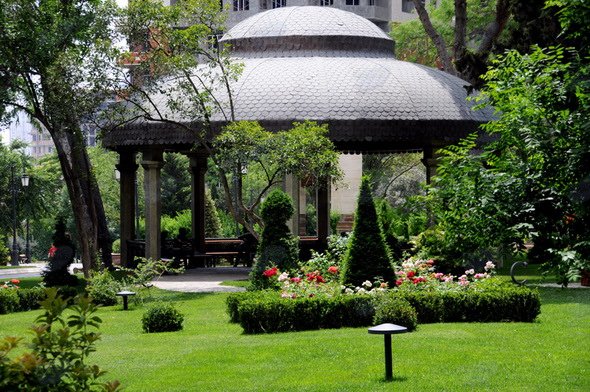 One of the oldest metropolitan parks – the Officers’ Park, formerly known as the boulevard, was laid during the Great Patriotic War in memory of heroes and victims who died in the battles against fascism. After the war, the park was named after the twice-hero of the Soviet Union, Hazi Aslanova. After the capital reconstruction, the Officers’ Park was reopened in 2011, despite the fact that work on the improvement of one of the park’s favorite parks started in 2009.
One of the oldest metropolitan parks – the Officers’ Park, formerly known as the boulevard, was laid during the Great Patriotic War in memory of heroes and victims who died in the battles against fascism. After the war, the park was named after the twice-hero of the Soviet Union, Hazi Aslanova. After the capital reconstruction, the Officers’ Park was reopened in 2011, despite the fact that work on the improvement of one of the park’s favorite parks started in 2009.
Having preserved some of the old features in the shadow of frozen perennial trees, the Officers’ Park of 4 hectares acquired at the same time a completely new look. Here there was an original lighting system, a majestic stone fountain and bronze statues, which today have become the visiting card of the central parks of Baku. Here the chessplayer, frozen in thought, plans his move, but a cheerful fussy chaikhan who meets visitors at the entrance. Not far from the fountain, on one of the benches is a tired bronze photographer. A little further, the girl offers a bouquet of flowers to passers-by. Another girl plays in classics, and just behind her a whole crowd of children, holding hands, froze in a frenzied dance.
In addition to bronze figures, various sculptures of swans are also attracting attention, as well as goggle-eyed fish, especially beloved by children, who are given special attention in the park. A special platform with attractions, merry go rounds, slides and swings, lined with a soft coating for the safety of kids.
In the park, an indoor skating rink with an area of 700 sq. m, as well as an unusual “ice” cafe, whose building attracts attention with its appearance and original design.
For the convenience of visitors in the park there are many stalls with ice cream, drinks and snacks, working tea-house – an ideal place for rest. What could be better than to drink aromatic tea with jam and sweets?! In a word, everyone here will find a way to relax. And the abundance of greenery and flowers fill the visitors’ holiday with a spring mood.
Sahil Park
In the center of Baku there is another large and well-groomed park where people like to spend time and the guests of the capital are the Sahil Park. Established in Soviet times, the park was formerly called “The Square of 26 Baku Commissars”. Here in the mass grave were buried the famous revolutionaries, and there was an architectural memorial with “eternal fire”, laid in their honor. After the collapse of the Soviet Union, the memorial was dismantled, and the square turned into a beautiful park. In 2009, the park appeared before visitors in a new shape after a thorough reconstruction.
Today here, right in the center of the park, is a huge, very beautiful three-tiered fountain in the form of a bowl, executed in the oriental style. The fountain of the water fountains year round pleases the rumor of tourists in the shadow of perennial trees, among which there are many palm trees, plane trees, ash trees and others. Also during the work in the park, benches, lights, new lawns were replaced.
It should be noted that the park, which is located in the central part of Baku, at the intersection of Khagani Street, Bulbul Avenue, Uzeyir Gazhibekov Street and Rashid Behbudov Street, opposite the Azerbaijan National Library named after MF. Akhundova, is surrounded by historical buildings.
There are buildings associated with the names of the great figures of Azerbaijani culture. For example, here is the house in which from 1937 to 1967 lived Bulbul – the great Azerbaijani opera singer, People’s Artist of the USSR, one of the founders of Azerbaijani vocal music.
In the same building, the Union of Artists of Azerbaijan is located, the corner of which looks at the intersection of Bulbul Avenue and Khagani Street. The Union was established in 1932 and unites many outstanding sculptors and painters of the Azerbaijan art school.
The building of the Azerbaijan National Library named after M.F. Akhundzade, which has one of the richest collections of books in the world and is a treasury of national culture, is also of considerable historical interest. This building was designed in 1949 by the outstanding Azerbaijani architect, academician Mikail Useynov. And the building was built in 1960. In the arches, located on the whole upper part of the facade of the building, you can see the sculptures of the great Azerbaijani and world figures of culture, art and science – Nizami Ganjavi, Hasan-bek Zardabi, Uzeyir Hajibeyli, Samed Vurgun, Alexander Pushkin, Dmitry Mendeleyev, Shota Rustaveli and others.
Many townspeople and guests of Baku with their families and children come to relax on spacious comfortable benches, to admire the magnificent fountains, strolling along the alleys with emerald lawns and an abundance of greenery. In the warm season, the park simply drowns in flowers – tulips, daffodils, roses.
Khagani’s garden (the Molokansky garden)
The Khagani Garden is one of the oldest parks in Baku. A small garden (0.8 hectares), which now named after a medieval , native poet Khagani Shirvani, was renamed several times. However, most of all this park is known as the Molokansky garden and it is no coincidence. In the XIX century, this garden was surrounded on all sides by caravanserais, in which Russian Molokans often brought goods from different counties. The nearest streets, alleys, courtyards were studded with cooperative workshops, where barrels, tubs and other wooden products were made. After the establishment of Soviet power, the Molokansky Garden was renamed the Garden on January 9 (in memory of the Bloody Sunday of 1905), and then it was given the name of Hashim Aliyev.
The basis of the architectural and landscape composition of the garden is a curvilinear form pool, with the sculpture group “Three Graces”, representing three sculptures of graceful girls. As a pedestal for them serve as large blocks of natural stone.
Columns of the garden pavilion begin with a water basin. The paths of the garden are traced in such a way that they penetrate its space diagonally and pass next to the central swimming pool. Although the garden is very small in size, it is quite cozy and is a favorite place for rest of many Baku residents. The green mass of the garden is located so that it creates large shady zones where benches for rest are located. Among the trees there are undergrowth of bushes and flower gardens.
It should be noted small architectural forms – light lanterns, newsstand, house-feeder for pigeons and other elements of landscape design characteristic of the Garden of Khagani.
Today, as before, the Baku residents and numerous guests of the capital like to gather in the kindergarten. There is a children’s playground with a lot of interesting swings and slides, a large café-restaurant, where you can refresh yourself, try ice cream, tea with jam or soft drinks.
Samed Vurgun Garden
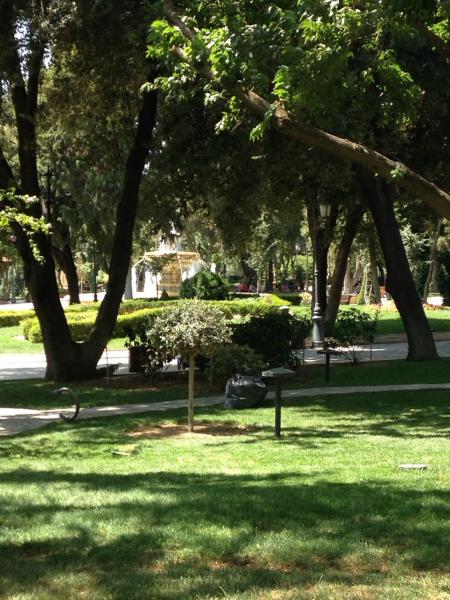 One of the oldest parks of the capital, now a park named after the national poet of Azerbaijan Samed Vurgun, was laid in 1882 on the site of the city garden merchant of iron goods Krasilnikov. The park is located in the city center near the Baku Railway Station and the Railway Administration building. In 1961 a monument to Samed Vurgun was erected in the park, the works of the sculptor F. Abdurrahmanov and the architect M. Useynov.
One of the oldest parks of the capital, now a park named after the national poet of Azerbaijan Samed Vurgun, was laid in 1882 on the site of the city garden merchant of iron goods Krasilnikov. The park is located in the city center near the Baku Railway Station and the Railway Administration building. In 1961 a monument to Samed Vurgun was erected in the park, the works of the sculptor F. Abdurrahmanov and the architect M. Useynov.
In 2009, the park appeared in front of the Baku residents and guests of the capital in an updated form after the restoration. Pedestrian paths are paved with sidewalk tiles, lawns are equipped, rich flower beds are broken. On some of them, flowers are seated in the form of a bottle symbol – a traditional motif that is often found on Azerbaijani carpets, kalagai, etc. Substantially restored in the park and elegant fountains, built here in Soviet times, the lighting was completely replaced – new lanterns were installed, comfortable benches were installed in the shade of age-old trees.
Currently in the park of Samed Vurgun everything looks harmonious and beautiful. The park is as before – a favorite vacation spot for thousands of citizens and guests of the capital. This is place where old and young people traditionally come. Young mothers, as well as grandmothers like to be understood here with children, young people come to sit in the shade and listen to music on headphones or go skating. Veterans, as a rule, do not mind knocking on dominoes and backgammon. Especially a lot of vacationers are near the park fountains in the warm season in the evenings.
Park Zorge
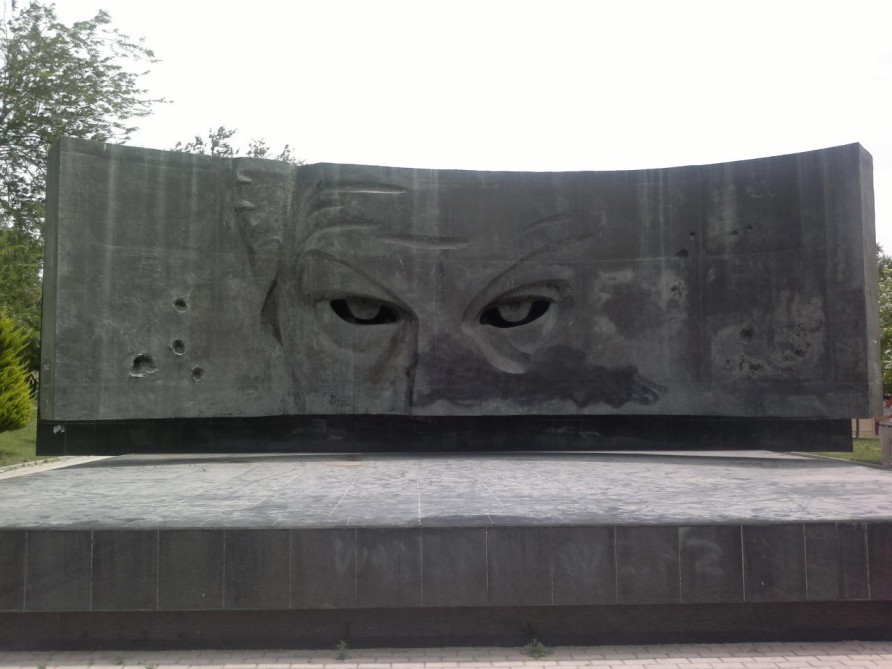 One of the oldest parks in Baku is the Park Zorge, located on a vast territory and combines several attractions, including a modern children’s amusement park. There are excellent conditions for recreation of the population; a lot of work has been done on landscaping and gardening.
One of the oldest parks in Baku is the Park Zorge, located on a vast territory and combines several attractions, including a modern children’s amusement park. There are excellent conditions for recreation of the population; a lot of work has been done on landscaping and gardening.
In 1981, a monument to the legendary Soviet intelligence officer Richard Sorge was erected in the park. The authors of the monument – the sculptor V. Tsygal and the architect R. Aliev – managed to transfer the original idea of the design in an original way. The monument is a wall with a scout face on it, whose gaze seems to be following the observers. In the park there are a lot of greenery, comfortable benches, and playgrounds. District-level events are held here.
No less remarkable is the monument to the national hero Koroglu, installed in the park in 2012. The height of the monument from the surface of the earth is 23 meters. The majestic monument to the hero Koroglu, sitting on horseback Gyrat, was cast from bronze in Ukraine. The author of the composition is the architect Tokay Mamedov.
There is also an entertainment complex Koala Park, which will be interesting for both children and adults.
Highland Park in Baku
 The mountain park, located in the center of Baku, has been considered for many years one of the most beautiful parks in the capital, and a favorite vacation spot for local residents. Another name of the park, which has settled down among the people – Observation platform. And in Soviet times the park named after politician Sergei Kirov.
The mountain park, located in the center of Baku, has been considered for many years one of the most beautiful parks in the capital, and a favorite vacation spot for local residents. Another name of the park, which has settled down among the people – Observation platform. And in Soviet times the park named after politician Sergei Kirov.
The mountain park is unique in that its territory offers a magnificent panorama of the city and Baku Bay, along which a wide strip stretches Seaside Boulevard, which explains the name of the park – Upland . Guided by this fact, back in the 30s of the XX century, when preparing the Baku master plan, it was envisaged that the Upland Park created here would be of great importance in the overall architectural composition of the capital.
The park was built by the architect LA Il’in from the colored limestone of the Baku quarries, in place of the old cemetery. By the way, one more early name of the park is connected with this cemetery – the English park. According to one version, in the twenties of the last century here, along with the bodies of the victims of the March events of 1918, British soldiers who arrived in Baku after the overthrow of the Russian emperor were buried.
Lev Ilin skillfully used the features of the relief of the complex area where the park was stretched. Witty connected by stairs and ramps walking alleys-terraces fancifully placed viewports best reveal the panorama of the Baku Gulf.
In 2013, the Upland Park was thoroughly reconstructed, being presented to the residents and guests of the capital literally transformed. When updating the park, the diversity of the relief was skillfully used. Thanks to the work done and the convenient location of the observation platforms, the park has further increased its attractiveness for tourists and residents of the capital.
New tracks and paths are laid in the park. A new complex of waterfalls was built on the territory of the park, landscaping works were carried out, old trees were preserved, new ornamental plants were planted. A modern lighting system makes the park even more beautiful.
In the cafe built in Upland Park, from the top floor of which you can observe the panorama of Baku and the Caspian. With the central urban area of Azneft, the park is connected by a Baku funicular, as well as a wide staircase descending the terraces planted with old pine trees.
The Upland Park also houses the Museum of Independence of Azerbaijan and the Shahid Alley, where the victims of the “Black January” in 1990 and the soldiers who died in the Karabakh war are buried.
Due to the presence of graves in the park, there is peace, there are no noisy attractions. But it is this silence that gives the visitors of the park peace of mind, pacification, caused by the noise of the pines. In combination with the stunning panorama that opens from the park, the sensations become unique.
Heydar Aliyev Museum and Park Complex
One of the most beautiful parks in Baku, Park. Heydar Aliyev, is located in the center of the city, near the Baku Musical Academy, in front of the Palace of Heydar Aliyev. On the day of the 82nd anniversary of the national leader Heydar Aliyev, the opening of an architectural complex including a monument to Heydar Aliyev was held here. The creation of the complex was worked by a group of Russian architects and sculptors under the direction of the Moscow’s chief artist, Igor Voskresensky. The total height of the monument is about 12 meters, the figure itself without a pedestal – above five meters. The whole square was completely reconstructed, which became known as the Museum and Park Complex of Heydar Aliyev.
There are three new fountains in the form of an eight-pointed star – the national symbol of Azerbaijan. Fountains are controlled by computers. For their facing from China was delivered one-piece 50-ton granite. Most of the complex, with a total area of 23 thousand square meters covered with marble slabs, brought from Russia, Brazil, Italy, Turkey and Kazakhstan. Flowers and a green lawn are delivered from Holland. Noteworthy the huge magnolia trees with luxurious white flowers blossom all summer. The park often hosts city events, the most significant of them is the annual Flower Festival. The celebration of this traditional holiday begins on May 10. During this period the park complex of Heydar Aliyev is decorated with various flower compositions.
Directly behind the Palace of Heydar Aliyev is located one more grandiose park complex, which was named “Winter Park” by the people. Here, an area of more than 7 hectares is planted in total about 2 thousand trees and more than 10 thousand ornamental shrubs from different countries, most of the territory is covered with lawn.
Five modern and rather unusual fountains, 6 underground and 4 elevated junctions, 13 elevators and 13 escalators (including those with disabilities) are built, three summer cafes and a 2-storey car park for 3500 vehicles are functioning in the Winter Park.
It is interesting that during the expansion of the territory during the construction of the road and the park complex, a unique operation was carried out – the house was moved by 10.6 meters. This three-story apartment house was erected in 1908 and belonged to the brothers Gadzhinsky. At a weight of 18,000 tons, it became the world’s heaviest building that was moved.
Fountain Square
 Fountain Square is the first city square in the capital of Azerbaijan in Baki. The name of the square speaks for itself. There are a lot of fountains here, both classical forms and avant-garde ones, for example, in the form of six steel balls lying on a wide pedestal. Around the square are monuments of architecture of the XIX and XX centuries, among which is the building of the museum named after Nizami (1860), the building of the cinema “Araz” (1870), etc.
Fountain Square is the first city square in the capital of Azerbaijan in Baki. The name of the square speaks for itself. There are a lot of fountains here, both classical forms and avant-garde ones, for example, in the form of six steel balls lying on a wide pedestal. Around the square are monuments of architecture of the XIX and XX centuries, among which is the building of the museum named after Nizami (1860), the building of the cinema “Araz” (1870), etc.
Fontan Square, formerly known as Parapet Square, was built in 1868 by the Baku city architect Kasym-bek Hajibababekov, on the initiative of the Baku Governor Kolyubekin and for some time was named in his honor – Kolyubakinskaya.
Later Parapet turned into a square named after Karl Marx. After the reconstruction of the 1950s (architect I. Tikhomirova), this square consolidated its position in the layout of the modern city. As a result, the square turned into a spacious, well-landscaped square square, connected with small old squares near the Press House and the library building. Occupying a central place in the central part of Baku, the square, along with Nizami Street (Torgovaya), has been in the focus of the main pedestrian flows for many years.
A new stage of reconstructive works on the transformation of the square was started in 1984. According to the idea of the architect-artist R. Seifullayev, the previously existing square was significantly modified. Substantially renewed the composition of green spaces, a view of the formerly unobtrusive group of exotic palms, the wide-deciduous deciduous trees began to look in a new way. The area of the square and square is covered with special concrete slabs of a reddish shade; The terraces and the steps of the square are edged with a white stone. Large squares for the flower beds were also made of white stone. An important part of the architectural and landscape composition of the park began to make up fountains. It is because of the large number of fountains that it began to be called the Fountain Square. The fountain in the center of the square is decorated with a sculptural composition. Another group of fountains was placed between the edge of the park and the surrounding historical buildings of the city.
In 2010, the Fountain Square underwent a complete reconstruction. Fountains, lanterns, pavilions and kiosks were reconstructed, vegetation was preserved, and the area of green plantations was increased. On July 2, the square opened to visitors. So today the square is really the face of the “new” part of the center of Baku.
Decorations of the square are sculptures of urban residents. For example, a bronze girl under an umbrella that talks on the phone – or sits on a bench by the fountain and induces makeup.
Akhundov garden
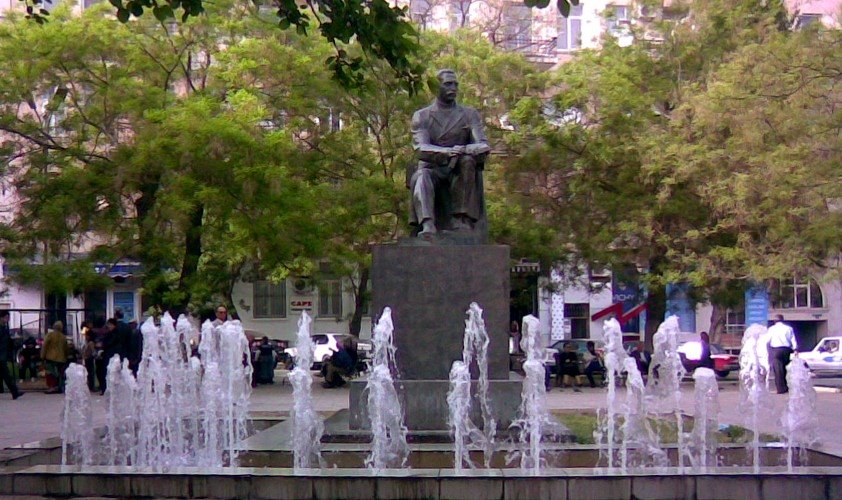 Garden named after M.F Akhundov, better known as the Akhundov garden, is located above the metro station “Icheri sheher”, at the intersection of the busy streets of Lermontov, Ahmed Javad and Said Rustamov. A monument to Azerbaijani writer, philosopher and enlightener Mirza Fatali Akhundov is erected in this ancient Baku square. This monument was installed in 1930, and the author of it is a Soviet sculptor Peter Sabsai. Although he was born in Odessa, but since 1926 he lived and worked in Baku.
Garden named after M.F Akhundov, better known as the Akhundov garden, is located above the metro station “Icheri sheher”, at the intersection of the busy streets of Lermontov, Ahmed Javad and Said Rustamov. A monument to Azerbaijani writer, philosopher and enlightener Mirza Fatali Akhundov is erected in this ancient Baku square. This monument was installed in 1930, and the author of it is a Soviet sculptor Peter Sabsai. Although he was born in Odessa, but since 1926 he lived and worked in Baku.
Despite the fact that the square is small, there is everything that is supposed to be in the park – cozy benches, original lamps, flower beds, marble paths, backlit bushes, flower seedlings in special pots, lawns. The garden is 1300 sq.m. completely restored in 2008. After the restoration, more than 3000 flowers and ornamental shrubs were planted here.
Near the garden there are interesting historical buildings. In the street of Said Rustamov there is the house of the oil-industrialist Dmitry Mitrofanov, whose construction was completed in 1903. The building is distinguished by original sub-balconies in the form of dragons and graceful capitals, and its facade is decorated with a lot of sculptures and a monogram “DM”. Near the house of Mitrofanov there is, so-called, a “pink mansion” – a dwelling house of the State Bank employees. In the architecture of this building were used elements Characteristic for residential buildings of the XIX century of Azerbaijani cities Sheki and Shusha .
Dede Gorgud Park
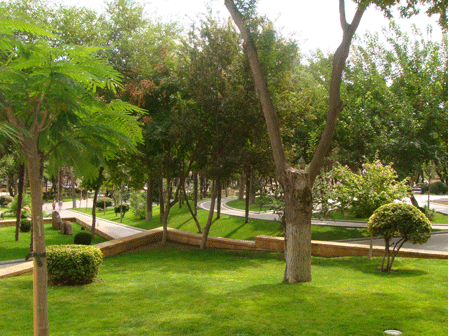 One of the modern parks – Dede Gorgud, opened in 2013 on the territory of 6 hectares, is one of the largest parks in the capital. Here all the conditions for recreation, landscaping, an artificial lake and an illumination system meeting modern standards have been created. Dede Gorgud’s Park is also a platform for demonstrating the ancient history and culture of Azerbaijan under the open sky. In the center of the park there is a monument “Kitabi-Dede Gorgud”, the work of the honored artist, sculptor Gerush Babayev.
One of the modern parks – Dede Gorgud, opened in 2013 on the territory of 6 hectares, is one of the largest parks in the capital. Here all the conditions for recreation, landscaping, an artificial lake and an illumination system meeting modern standards have been created. Dede Gorgud’s Park is also a platform for demonstrating the ancient history and culture of Azerbaijan under the open sky. In the center of the park there is a monument “Kitabi-Dede Gorgud”, the work of the honored artist, sculptor Gerush Babayev.
The epic “Kitabi-Dede Gorgud” is a grandiose monument of art, an age that is estimated at 1300 years, reflecting the historical past of the Azerbaijani people. The work reflects patriotism, heroism, wisdom, the historical past of the people, foresight, spiritual values, customs and traditions of Oguz Turks, Azerbaijani toponyms. This dastan (epic) is an indispensable source for studying the ancient subtleties of our language, historical events and personalities, the culture of our people.
The territory of the park is equipped with an artificial lake, an area of three hectares and a waterfall. Visitors to the park can rent and ride on the lake on catamarans. Two berths have been built for this purpose. In addition, bridges for walks have been built in the lower part of the artificial waterfall, as well as over a small bay provided for special aquatic plants.


